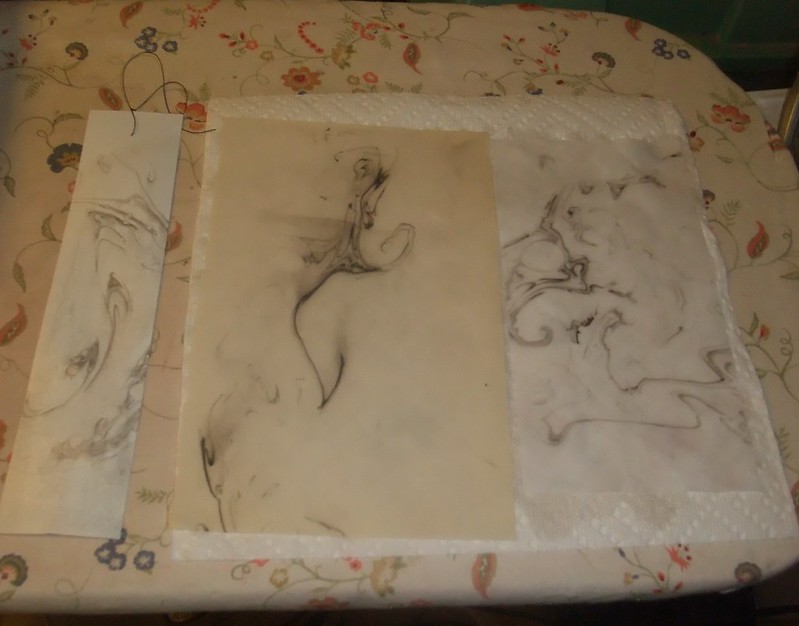Saionji Shonagon
New Member
 One dreamed of becoming somebody. Another remained awake and became. (Found in a fortune cookie.)
One dreamed of becoming somebody. Another remained awake and became. (Found in a fortune cookie.)
Posts: 7,240
|
Post by Saionji Shonagon on Jun 10, 2013 22:31:18 GMT -5
Having discovered that cheap Daiso Japan practice calligraphy paper is prone to disintegration when attempting suminagashi, I did some paper tests this evening with some things I had in the house. From left to right: Card stock left over from a previous project. Curled when wet, however, it took a decent print of the swirling ink and flattened back out as it began to dry. Has potential for things like bookmarks or greeting cards. Center: sketch pad paper intended for pencil, charcoal or pastels. Didn't come apart when wet, but the ink ran and smudged instead of taking a clean impression. Yasutomo "rice paper" for calligraphy. (I knew I'd bought a roll of it awhile back!) Requires careful handling to avoid tearing once wet, but was still significantly less fragile than the thin practice paper we tried on Saturday.* It took the ink print beautifully.  *Not surprisingly, we tried suminagashi on a bargain brand paper towel during my class. It took longest to dry because it's job is to saturate, but got a pretty decent print on it. |
|
Deleted
Deleted Member
Posts: 0
|
Post by Deleted on Jun 11, 2013 9:36:42 GMT -5
Yasutomo "rice paper" for calligraphy. (I knew I'd bought a roll of it awhile back!) Requires careful handling to avoid tearing once wet, but was still significantly less fragile than the thin practice paper we tried on Saturday. Might it be possible to get a paper-making screen under the paper after it soaks up the ink (or maybe before the ink is applied to the surface) and use that screen to gently lift the paper from the marbling? I don't know if that would interfere with the marbling process. |
|
Saionji Shonagon
New Member
 One dreamed of becoming somebody. Another remained awake and became. (Found in a fortune cookie.)
One dreamed of becoming somebody. Another remained awake and became. (Found in a fortune cookie.)
Posts: 7,240
|
Post by Saionji Shonagon on Jun 11, 2013 12:04:20 GMT -5
Might it be possible to get a paper-making screen under the paper after it soaks up the ink (or maybe before the ink is applied to the surface) and use that screen to gently lift the paper from the marbling? I don't know if that would interfere with the marbling process. Too much juggling, I think, particularly given the size of my marbling trays. You're really just supposed to lay the paper down and take it right back out again, then lay it out flat to dry. When we were playing with the fragile paper on Saturday, we found it easier to tear sheets in half and marble the smaller pieces. I think the Yasutomo paper will work, I just need to practice with it. My calligrapher friend, Richard, mentioned a place in SF Chinatown I might try for other calligraphy-grade papers. (He's currently doing lots of large format work which needs to hold up to a lot of wet ink.) |
|
|
|
Post by Kagami Tomoko on Jun 1, 2015 23:49:50 GMT -5
I recently met a women who deals in Japanese papers for (suminagashi) artists, architecture, and book binding. Her papers are beautiful and she has a website! Posted with her permission: www.washiarts.com/ |
|